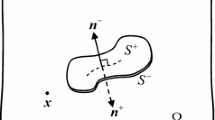Abstract
This seems to be the first exact closed form solution to the problem of a penny-shaped interface crack, subjected to an axisymmetric normal and tangential loading. The crack is located at the boundary between two bonded piezo-electric transversely isotropic half-spaces, made of different materials. We use the combination of Green’s functions for 2 different half-spaces and Fourier transform. We derive first the governing equations, which are valid for a crack of arbitrary shape. The usual approach leads to 4 hypersingular integral equations, we arrive at 3 integro-differential equations (one of them being complex). While the coefficients of the governing equations in existing publications are presented in terms of the results of the solution of a set of linear algebraic equations and are too cumbersome to be written explicitly in terms of the basic constants, our choice of the basic constants leads to quite elegant explicit expressions for these coefficients and reveals certain symmetry, which was noticed only numerically in previous publications or not noticed at all. In the particular case of axial symmetry, the problem is reduced to just one singular equation, for which exact closed form solution is known. We are not aware of any other publication with which our results can be compared.
Similar content being viewed by others
References
Fabrikant VI (2010) Contact and crack problems in linear elasticity. fabrikant-research.webs.com
Fabrikant VI (2021) New approach to interface crack problems in transversely isotropic materials. ZAMP, pp. 72-86
Mossakovskii VM, Rybka MT (1964) Generalization of the Griffith-Sneddon criterion to the case of inhomogeneous body. Prikl Mat Mekh 28(6):1061–1069
Willis JR (1972) The penny-shaped crack on an interface. Quart J Mech Appl Math 25:367–385
Zhao MH, Fang PZ, Shen YP (2004) Boundary integral-differential equations and boundary element method for interfacial cracks in three-dimensional piezoelectric media. Eng Anal Bound Elem 28:753–762
Author information
Authors and Affiliations
Corresponding author
Additional information
Publisher's Note
Springer Nature remains neutral with regard to jurisdictional claims in published maps and institutional affiliations.
Appendix 1
Appendix 1
We present below the table of Fourier integral transforms, used in this article.
The following notation was introduced in the formulas above:
Rights and permissions
Springer Nature or its licensor (e.g. a society or other partner) holds exclusive rights to this article under a publishing agreement with the author(s) or other rightsholder(s); author self-archiving of the accepted manuscript version of this article is solely governed by the terms of such publishing agreement and applicable law.
About this article
Cite this article
Fabrikant, V.I. Exact solution to axisymmetric interface crack problem in piezo-electric transversely isotropic materials. Meccanica 58, 1787–1798 (2023). https://doi.org/10.1007/s11012-023-01687-w
Received:
Accepted:
Published:
Issue Date:
DOI: https://doi.org/10.1007/s11012-023-01687-w



